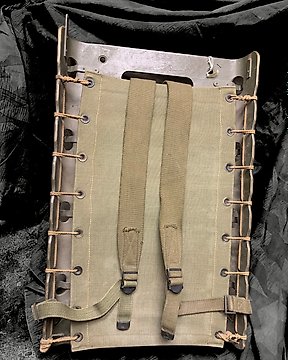
Estados Unidos de América - Cartón estadounidense WW2 1944/1945 - Accesorios militares
N.º 81210599

N.º 81210599

Nice 100% original 9th US Army Airforce Wool shirt shirt, a nice size and complete, and NAMED to Earl R van Fleet, with his name multiple stamped in the shirt, as well as his service number (very big - great for display!). A lot can be found on Earl; according his obituary, he: ''Earl served in the U.S. Army during WWII, he received 4 Bronze stars- Normandy, Northern France, Rhineland, and the Central European Campaign; he also received the American Theatre Campaign ribbon, Good Conduct Award, European-African-Middle East Campaign ribbon, and 3 overseas bars. He received an honorable discharge on November 8, 1945.'' See attached screenshots of him, he enlisted in 1943 and served at least 1,5 years overseas, i.e., throughout the complete European campaign.
A really great shirt, in very nice condition - should be more investigated. The label has been worn out over the years.
A very nice and 100% original shirt of the famous 9th USAAF that endured heavy combat above Europe during WW2!
History of the 9th USAAF
Operations in Europe 1944–1945
On D-Day, IX Troop Carrier Command units flew over 2000 sorties conducting combat parachute jumps and glider landings as part of American airborne landings in Normandy of Operation Neptune. Other Ninth Air Force units carried out massive air attacks with P-51 Mustang, P-47 Thunderbolt fighter-bombers, North American B-25 Mitchell and Martin B-26 Marauder medium bombers. Air cover during the morning amphibious assault by Allied forces on the beaches of France was flown by P-38 Lightnings.
With the beaches secure, its tactical air units then provided the air power for the Allied break-out from the Normandy beachhead in the summer of 1944 during the Battle of Cherbourg, Battle for Caen, and the ultimate breakout from the beachhead, Operation Cobra.
Unlike Eighth Air Force, whose units stayed in the United Kingdom, Ninth Air Force units were very mobile, first deploying to France on 16 June 1944, ten days after the Normandy invasion by moving P-47 Thunderbolts to a beach-head landing strip.
Because of their short range, operational combat units would have to move to quickly prepared bases close to the front as soon as the Allied ground forces advanced. The bases were called "Advanced Landing Grounds" or "ALGs". On the continent, many ALGs were built either from scratch or from captured enemy airfields throughout France, the Low Countries and Germany. Ninth Air Force units moved frequently from one ALG to another.
By early August most Ninth Air Force operational fighter and bomber groups were transferred to bases in France and assigned to the U. S. Twelfth Army Group. These groups were then assigned to Tactical Air Command (TAC) organizations which supported Army ground units. XXIX Tactical Air Command (XXIX TAC) was activated in France on 15 September 1944, commanded by Brig. Gen. Richard E. Nugent, to support operations of the U.S. Ninth Army.
XXIX TAC supported the Ninth Army in the north; IX TAC supported the First Army in the center; and XIX TAC supported the Third Army in the south. Air cover over Allied-controlled areas on the continent was performed by the IX Air Defense Command. Ninth Air Force groups made numerous moves within France, the Low Countries and western Germany to keep within range of the advancing battle front before the end of hostilities in May 1945.
During Operation Dragoon, the invasion of Southern France in August 1944, two Ninth fighter groups were transferred to the provisional United States/Free French 1st Tactical Air Force supporting the invasion force's drive north. As part of Operation Market-Garden, the Ninth Air Force transferred its entire IX Troop Carrier Command with its fourteen C-47 groups to the 1st Allied Airborne Army in September 1944. Those troop carrier groups flew many of the C-47s and towed CG-4 Waco gliders for the Allied airborne unit drops—Operation Market Garden—to take the bridges northwest of Eindhoven at Son (mun. Son en Breugel), Veghel, Grave, Nijmegen and Arnhem in the Netherlands.
In December 1944 through January 1945, Ninth Air Force fighters and bombers were critical in defeating the Wehrmacht during the Battle of the Bulge. Initially American, British, and Canadian air power was grounded by very bad winter weather, but then the bad weather broke, freeing the tactical air forces to help break the back of the Wehrmacht attack. The long smash across France, Belgium, and Luxembourg was the highlight[citation needed] of the existence of the 9th Air Force.
In the spring of 1945, Ninth Air Force troop carrier units flew airborne parachute and glider units again during Operation Varsity, the Allied assault over the Rhine River on 24 March 1945. Operation Varsity was the single largest airborne drop in history. The operation saw the first use of the Curtiss-Wright C-46 Commando transport in Europe, operating with the reliable C-47 Skytrain of previous airborne operations, an experiment which ended with the catastrophic loss of 28% of the C-46s participating.
Cómo comprar en Catawiki
1. Descubre algo especial
2. Haz la puja más alta
3. Paga de manera segura